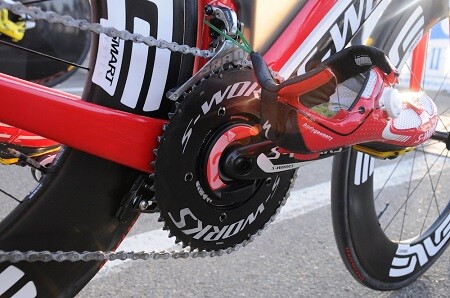5 reasons to use a potentiometer

Un power meter is an apparatus that calculates the power developed by the cyclist by measuring the amount of force that is applied to a certain part of the bicycle by strain gauges, which allow to calculate what is the force that is applied to said part of the bicycle
Our collaborator Ricard Perez, tells us in this article why we use a potentiometer in our workouts.
Despite the fact that the first power meter in cycling was made in 1986, it has not been until a few years ago that these training control devices are becoming popular in both cycling and triathlon.
Un power meter is an apparatus that calculates the power developed by the cyclist by measuring the amount of force that is applied to a certain part of the bicycle by strain gauges, which allow to calculate what is the force that is applied to said part of the bicycle
Many athletes who train using a heart rate monitor are very reluctant to go to the world of potentiometers because they believe that it does not provide them with enough advantages to make the disbursement associated with the acquisition of these devices.
Then you have 5 advantages of using the potentiometer in front of the heart rate monitor.
1.- Specific
The potentiometers are devices created to be used exclusively on a bicycle so they have more specific options for cycling than the pulsometers, such as cadence.
2.- Objective
In situations of nerves, tiredness and even humidity in the environment, our heart rate increases, and that is not synonymous with that we are working harder.
When a potentiometer indicates the watts that we are generating, this value is totally objective and however nervous we may get, we will not be able to increase that value (unless our legs do their part of the job).
3.- Immediate
Our heart does not have the capacity to change its frequency immediately, that is, we can not go from 120ppm to 190ppm in less than a second. The increase of pulsations is a progressive change that for submaximal efforts requires a minimum of 45 seconds to stabilize.
That is to say, if we are doing an exercise of sprints or thrown exits, we can not use the heart rate monitor as a control device because when we are dealing with 10 and 30 seconds of duration, we will reach our maximum pulsations once the exercise is finished.
The potentiometers show us the immediate watt data that we are generating in each pedal stroke, so we can use a power measurement to control this type of explosive exercises.
![]()
4.- Comparable
When an athlete starts in the cycling training In a usual way, the heart rate range is highly variable, since initially the roe deer is stressed very easily, and only through prolonged training over the months can we stabilize these pulsations.
Thus, when starting to train with the bicycle our heart rate monitor will mark a very high pulsations that throughout the season will decrease due to our adaptation to exercise.
With a potentiometer, we are obtaining numerical values that indicate the power of our body, and not the activity of our heart (which we remember, is influenced by external agents), so that we can compare our evolution at any time with absolute values .
5.- Trasladable
What is the feeling we have just before starting a competition?
Nerves, which translates into a very noticeable increase in our pulsations.
If we want to take our training pulsations as a reference, to reproduce the same intensity during a competition, we must take into account the factor of the nerves in the formula.
Another element that can distort the control of the competition is the fact of training in a place with a humidity very different from the place of competition (since humidity also modifies our pulsations).
Using a potentiometer, we can isolate external elements of our formula, which makes it much easier to transfer the values we obtain by training in the context of a competition.
Further information: http://www.ricardperez.com/
There are no previous results.




























